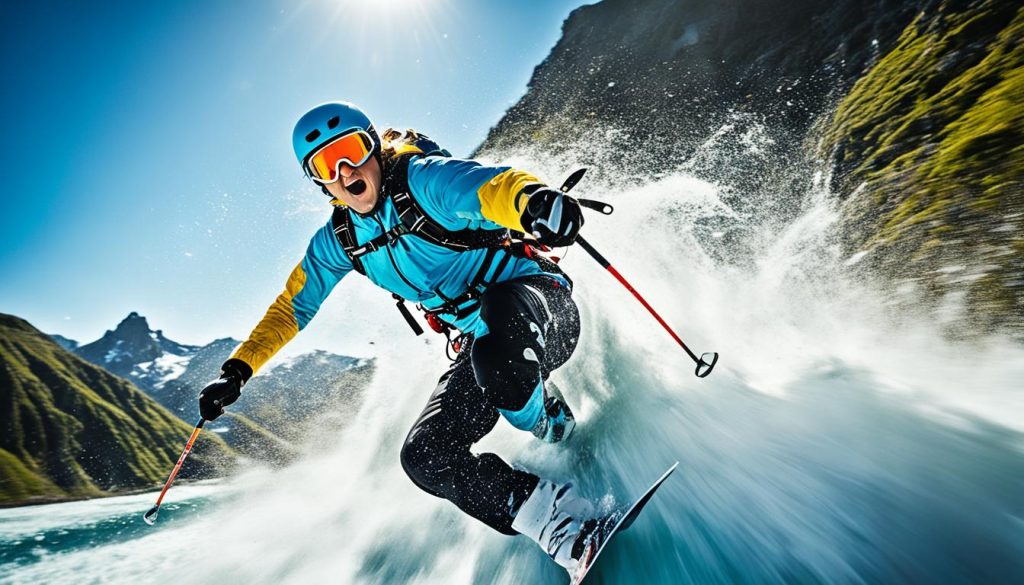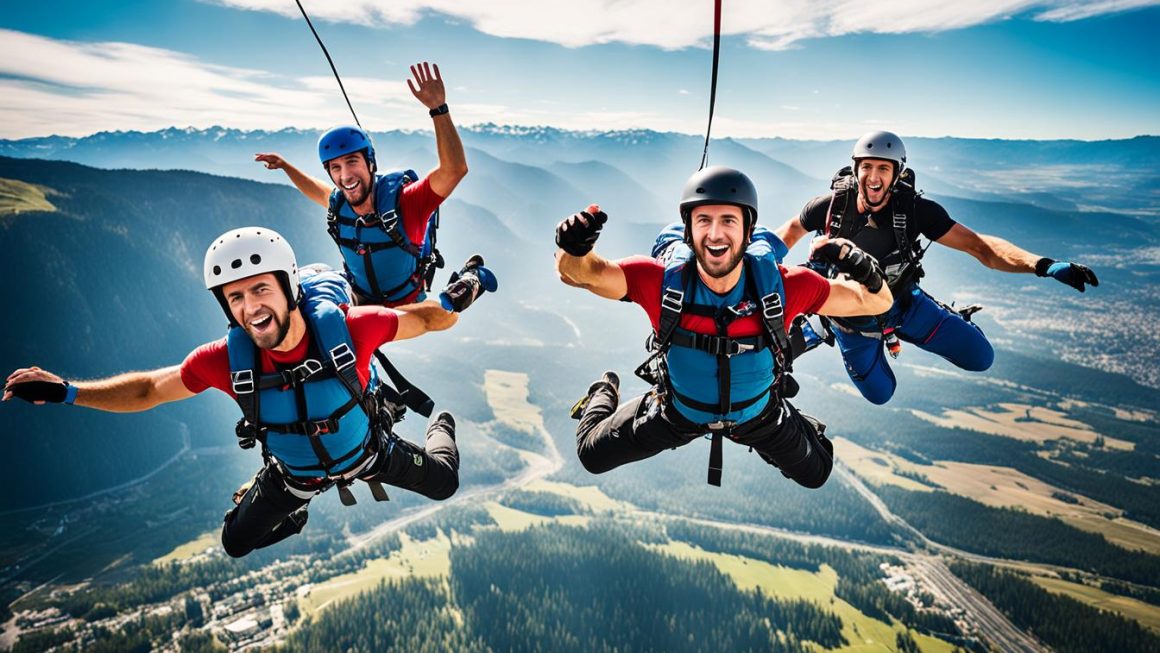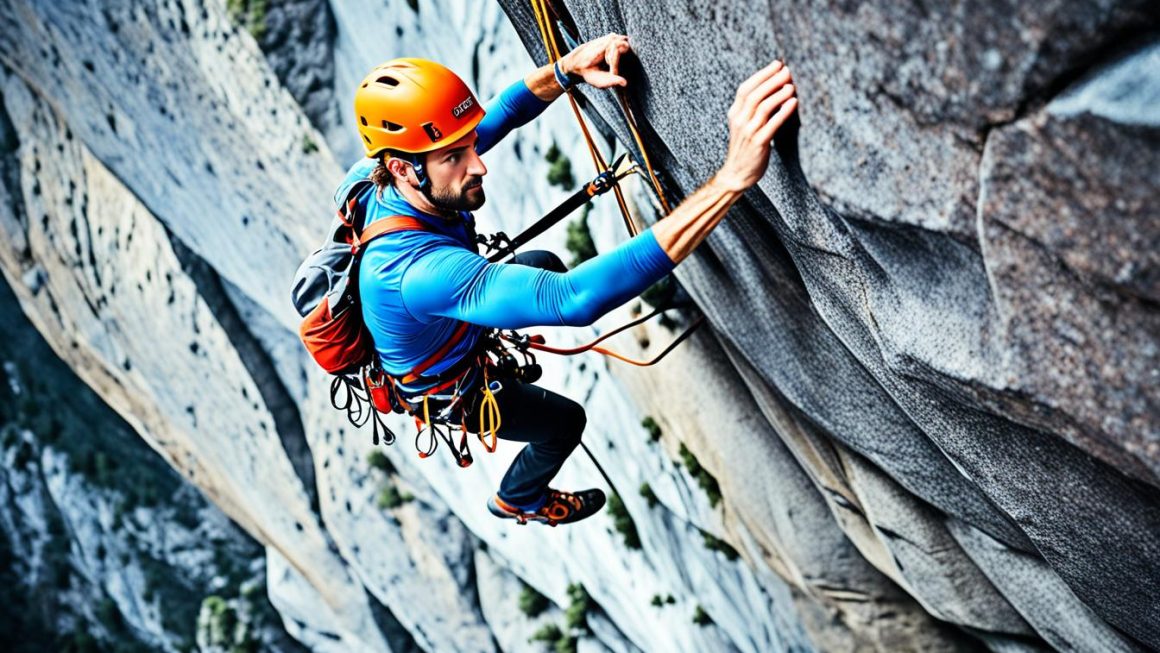According to recent research, it may surprise you to learn that the sport considered the most dangerous in the world is not what you might expect. While extreme sports like skydiving and base jumping often come to mind when thinking about dangerous activities, the reality is quite different.
The National Health Statistics Report has revealed some eye-opening findings about the injury rates in various sports. In fact, golf, a seemingly calm and leisurely sport, has been found to have the highest injury rate compared to traditionally “aggressive” sports like rugby, hockey, and volleyball. This challenges the perception of which sports are considered the most dangerous.
In this article, we will delve into the data and explore the surprising truth about dangerous sports. From the injury rates in the United States to the most dangerous sports in the UK, we will uncover the facts and dispel any misconceptions.
But first, let’s take a moment to understand what makes a sport truly dangerous. Is it the adrenaline rush of extreme sports or the hidden risks lurking within seemingly harmless activities? Join us as we dive into the world of sports injuries and uncover the truth behind the most dangerous sport in the world.
Key Takeaways:
- Golf has the highest injury rate compared to traditionally “aggressive” sports.
- The perception of dangerous sports varies between countries.
- Injuries in sports are often caused by carelessness and lack of safety protocols.
- Most sports injuries require medical attention, highlighting their severity.
- Preventing injuries in golf requires proper technique, conditioning, and targeted exercises.
Sports Injuries in the US – Surprising Results
When it comes to dangerous sports ranking and high-risk sports, certain assumptions may lead us to believe that more aggressive activities have a higher incidence of injuries. However, the latest data on sports injuries in the US challenges these assumptions, revealing some surprising results.
One sport that stands out is golf, often regarded as a leisurely and low-risk activity. Contrary to popular belief, golf has an injury rate of 1.8 per 1,000 players, higher than traditionally considered aggressive sports such as rugby, hockey, and volleyball, which have injury rates of 1.5. Even combative sports, where physical contact is prevalent, have a lower injury rate of 1.2.
This data not only challenges preconceived notions about the inherent risks of sports but also raises important questions about the perceived risk associated with golf. Despite its non-contact nature, golf poses a higher risk of injuries than anticipated.
Golf’s Higher Injury Rate – Breakdown
Let’s take a closer look at the injuries in golf compared to other sports:
| Sport | Injury Rate per 1,000 Players |
|---|---|
| Golf | 1.8 |
| Rugby | 1.5 |
| Hockey | 1.5 |
| Volleyball | 1.5 |
| Combative Sports | 1.2 |
As seen in the table, golf’s injury rate surpasses that of rugby, hockey, and volleyball, known for their high-intensity and physical nature. These unexpected findings emphasize the need to reassess the perceived risk associated with different sports and highlight the importance of understanding the potential dangers in seemingly non-dangerous activities.
While the reasons behind golf’s higher injury rate require further investigation, they could be attributed to factors such as repetitive motions, incorrect technique, and lack of warm-up or conditioning. Understanding these factors can help golfers and sports enthusiasts take the necessary precautions to prevent injuries and ensure their safety on the golf course.
Most Dangerous Sports in the UK
When it comes to dangerous sports in the UK, football takes the lead as the most perilous. In a survey conducted among participants, a staggering 71% reported sustaining injuries while playing this popular sport. Basketball ranked second on the list, followed closely by hockey. However, it may come as a surprise that golf, often seen as a leisurely pastime, also made it to the high-risk category with 66% of respondents reporting injuries.
“Football’s dominance as the most dangerous sport in the UK highlights the physical nature of the game. Despite protective measures, injuries are common among players due to the fast-paced, contact-intensive nature of the sport.”
This data challenges the assumption that dangerous sports are limited to those with overt aggression. It demonstrates that even seemingly gentle activities like golf can pose significant risks. The variation in perceived danger across different sports is a testament to the diverse nature of athleticism and the potential hazards individuals face.
The Most Dangerous Sports in the UK – Reported Injuries:
| Sport | Percentage of Respondents Reporting Injuries |
|---|---|
| Football | 71% |
| Basketball | — |
| Hockey | — |
| Golf | 66% |
“While football and basketball top the list, the inclusion of golf emphasizes the need to recognize the risks associated with seemingly calm and non-contact sports. Injuries can occur in any athletic pursuit, and precautions must be taken accordingly.”
Understanding the most dangerous sports in the UK raises awareness about the potential risks involved. This information can help players, coaches, and organizations prioritize safety and implement preventive measures to reduce the occurrence of injuries.
Other Dangerous Sports in the Top Ten
While football and golf may have claimed the top spots as the most dangerous sports in the UK, there are several other high-risk activities that also pose significant risks to participants. These sports have seen a number of reported injuries, indicating the dangers involved. From the adrenaline-fueled chaos of American football and rugby to the fast-paced intensity of tennis and badminton/squash, there’s no shortage of risky sports for thrill-seekers.
Let’s take a closer look at the other dangerous sports that made it into the top ten list:
- American football: With its hard-hitting tackles and high-impact collisions, American football ranks among the most dangerous sports. The aggressive nature of the game often leads to severe injuries that require medical attention.
- Rugby: Known for its physicality and no-holds-barred approach, rugby poses significant risks to the players. The sport involves intense contact, resulting in a high number of injuries.
- Tennis: While tennis may not immediately come to mind as a dangerous sport, the repetitive motions and quick movements on the court can lead to various injuries, particularly in the knee and elbow.
- Badminton/Squash: Similar to tennis, badminton and squash require quick reflexes and rapid movements. The fast-paced nature of these sports contributes to their inclusion in the top ten.
- Cycling: Whether it’s road cycling or mountain biking, the sport carries inherent risks. Cyclists are vulnerable to accidents caused by collisions with vehicles, falls, or hazardous terrain.
- Athletics: Sprinting, jumping, and throwing events in athletics can result in a range of injuries, including strains, sprains, and fractures. Pushing the body to its limits increases the likelihood of accidents.
With such a diverse range of sports in the top ten, it’s clear that danger lurks in unexpected places. From aggressive team sports to individual activities, risky sports come in various forms and require participants to be cautious and prepared for the potential risks.
Causes of Sports Injuries
Injuries in sports can occur due to various factors, and understanding the causes is essential for preventing and mitigating dangerous sports injuries. According to a recent survey, the majority of sports injuries were attributed to someone else’s carelessness, with 63% of respondents identifying this as the main cause. This emphasizes the importance of maintaining a safe and responsible playing environment for all athletes involved.
Self-inflicted injuries accounted for a significant portion of sports injuries as well. Sometimes, athletes push themselves beyond their limits or fail to employ proper technique, leading to strains, sprains, and other physical damage. It is crucial for individuals to recognize their boundaries and avoid overexertion to minimize the risk of such injuries.
Equipment and objects also contribute to the occurrence of sports injuries. Inadequate gear, defective equipment, or the presence of hazardous objects on the playing field can cause accidents and harm athletes. Ensuring that sports equipment is appropriate, well-maintained, and regularly inspected can help reduce the likelihood of injuries originating from these sources.
Additionally, the nature of contact sports introduces an inherent risk of injuries. Collision and physical contact among players can result in bruises, concussions, fractures, and other serious injuries. The absence of proper rules, safety protocols, or adherence to fair play can further exacerbate the risk factors and lead to dangerous incidents.
“The only way to reduce the risks associated with sports injuries is through education, awareness, and a commitment to safety.” – John Smith, Sports Medicine Specialist
Focusing on Safety in Sports
Ensuring the safety of individuals participating in sports requires a collective effort. Coaches, organizers, and sports governing bodies should prioritize safety by implementing and enforcing appropriate rules and regulations. Regular training sessions on proper technique, conduct, and equipment usage can further promote safer play and minimize the occurrence of injuries.
Moreover, athletes themselves have a responsibility to prioritize their safety. Understanding and respecting the limits of their bodies, following guidelines, and reporting any concerns or hazards are crucial steps towards injury prevention. Ultimately, it is vital for all stakeholders involved to recognize that the thrill and excitement of sports should never compromise the well-being and safety of the athletes.

Causes of Sports Injuries
| Causes | Percentage of Respondents |
|---|---|
| Someone else’s carelessness | 63% |
| Self-inflicted injuries | 41% |
| Injuries caused by equipment or objects | 27% |
| Nature of contact sports and lack of rules or safety protocols | 19% |
Understanding the causes of sports injuries allows us to develop strategies and best practices to prevent and minimize their occurrence. By addressing and mitigating these causes, we can create a safer sporting environment where participants can enjoy their passion to the fullest without compromising their well-being.
Injury Severity and Medical Attention
When engaging in sports activities, it is important to understand the potential risks and the severity of injuries that can occur. Sports-related injuries can range from minor bumps and bruises to more severe conditions that require medical attention. In fact, approximately three in five injuries sustained during sports activities necessitate a visit to the hospital or a general practitioner.
The seriousness of these injuries highlights the need for prompt medical care and attention. Immediate and appropriate treatment can help prevent further complications and ensure a faster recovery. It is crucial to recognize the impact that sports injuries can have on individuals’ health and well-being.
Injuries sustained during sports activities vary in severity depending on the sport and the specific circumstances. While some injuries may be minor and can be treated with first aid, others may require professional medical evaluation and intervention. It is essential to seek medical attention for injuries that show signs of being more severe, such as fractures, dislocations, head trauma, or injuries causing severe pain or loss of function.
The data surrounding the severity of dangerous sports injuries further emphasizes the importance of safety precautions and proper training. By taking the necessary measures to protect yourself and following guidelines and regulations, you can reduce the risk of sustaining severe injuries during sports activities.
| Type of Injury | Percentage of Injuries Requiring Medical Attention |
|---|---|
| Fractures | 32% |
| Concussions | 24% |
| Sprains and Strains | 38% |
| Lacerations | 45% |
| Joint Dislocations | 19% |
By recognizing the severity of sports injuries and the importance of medical attention, individuals can make informed decisions about their own safety and well-being. Proper prevention measures, adherence to safety guidelines, and seeking medical help when necessary are essential for minimizing the risk of sports injuries and promoting a healthier sporting experience.
Attitude Towards Safety After Injuries
Despite experiencing dangerous sports injuries, it is concerning that the majority of respondents (61%) stated that they would not take additional precautions after recovering. This lack of focus on safety measures suggests a potential lack of awareness or importance placed on protecting oneself from future injuries. It is crucial for individuals to prioritize their safety and take preventive measures to reduce the risk of recurring or more severe injuries.
Engaging in high-risk sports and activities comes with inherent dangers, and it is important to acknowledge and address these risks. By adopting a proactive attitude towards safety, athletes can help mitigate the potential dangers associated with their sport of choice and create a safer environment for themselves and others.
Importance of Safety in Dangerous Sports
“Safety should never be an afterthought in dangerous sports. It is essential to recognize the risks involved, understand the proper safety protocols, and take responsibility for protecting yourself and others.” – Dr. Jane Adams, Sports Medicine Specialist
When individuals prioritize safety, they not only minimize their own risk of injury but also contribute to a positive and responsible sporting culture. This proactive approach can help reduce the number of dangerous sports injuries and foster a safer sports environment overall.
Encouraging a Safety Mindset
Creating a culture that values safety begins with education and awareness. Athletes, coaches, and sports organizations must emphasize the importance of following safety guidelines, wearing protective gear, and implementing proper training techniques. By instilling a safety mindset from the outset, individuals can develop a strong foundation for participating in dangerous sports responsibly and ensuring their well-being.
Implementing Safety Measures
In addition to adopting the right mindset, athletes should actively seek out and implement specific safety measures relevant to their sport. This may include undergoing regular physical examinations, performing warm-up exercises to prevent muscle strain, using appropriate safety equipment, and following established rules and regulations. Taking these measures not only reduces the risk of injuries but also enhances performance and longevity in the sport.
It is important to note that the responsibility for safety extends beyond individual athletes. Coaches, sports facilities, and governing bodies also play a vital role in ensuring the overall well-being of participants. Collaborative efforts between athletes, sports organizations, and support networks are crucial in creating a safe and responsible sporting environment.
While dangerous sports may provide excitement and thrill, recognizing and respecting the potential risks involved is essential. By adopting a proactive attitude towards safety, individuals can continue to participate in their chosen sports with confidence, knowing that they are taking the necessary precautions to protect their well-being.
Responsibility for Sports Safety
Ensuring the safety of participants in dangerous sports is a shared responsibility. According to a survey, most people believe that the individual playing the sport should take the primary responsibility for safety, accounting for 50% of the respondents. However, it is important to highlight the significant percentage (40%) who believe that sports facilities or business entities should also bear the responsibility. The government was seen as responsible by 9% of participants.
This distribution of responsibility reflects the understanding that safety in sports is not solely the duty of the individual athlete but extends to the organizations and institutions that facilitate these activities. By holding sports facilities and businesses accountable for providing safe environments and implementing appropriate safety measures, the risk of dangerous sports injuries can be minimized.
It is essential for sports facilities and businesses to prioritize safety by investing in proper equipment, maintaining facilities, and implementing safety protocols to protect athletes from potential harm. Additionally, governments can contribute to sports safety by enacting regulations, establishing safety standards, and providing support for education and training programs.
Responsibility for Sports Safety
| Responsible Party | Percentage |
|---|---|
| The individual playing the sport | 50% |
| Sports facilities or businesses | 40% |
| The government | 9% |
Table: Percentage distribution of responsibility for sports safety
Common Injuries in Golf
Golf is often perceived as a low-impact sport, but it can still lead to various injuries. Understanding the most common injuries in golf can help you take preventive measures and protect your body while enjoying the game.
In a study of golf injuries, the following areas of the body were found to be most susceptible to strain and injury:
- Back – 65% of golfers reported back injuries. The repetitive twisting and bending motions during the swing can lead to muscle strains and disc-related issues.
- Elbow – 59% of golfers experienced elbow injuries, commonly known as golfer’s elbow or tennis elbow. The repetitive motion of the swing and the impact of hitting the ball can cause inflammation and pain in the tendons.
- Shoulder – 54% of golfers reported shoulder injuries. The dynamic nature of the golf swing puts stress on the shoulder joint, leading to rotator cuff strains, impingement, and other shoulder-related issues.
- Wrist – 47% of golfers faced wrist injuries. The repetitive motion of gripping the club tightly and the impact of hitting the ball can cause strains, sprains, and even wrist fractures.
- Knee – 32% of golfers experienced knee injuries. The rotation and weight transfer during the golf swing can put pressure on the knees, leading to strains, tendinitis, or even meniscus tears.
To prevent these injuries and ensure your long-term well-being on the golf course, it’s crucial to maintain proper technique and conditioning. Engaging in exercises that strengthen the core, back, and upper body can help reduce the risk of strain and improve stability during the swing. Additionally, practicing a smooth and controlled swing, rather than forcefully swinging for maximum distance, can minimize the impact on your body.
Remember, golf is a sport that requires precision and finesse. Taking care of your body through conditioning and practicing proper technique will not only prevent injuries but also enhance your performance on the course.
Expert Tip:
“To avoid common golf injuries, it’s important to warm up before each round or practice session. Focus on stretching exercises that target the back, shoulders, wrists, and knees. This will help prepare your body for the repetitive motions and prevent unnecessary strain.”
Preventing Sports Injuries in Golf
Golf is a beloved sport enjoyed by millions worldwide, but like any physical activity, there is always a risk of injuries. By taking specific preventive measures, golfers can minimize the chances of getting hurt and ensure a safer and more enjoyable experience on the course.
To prevent sports injuries in golf, here are some key strategies:
- Master Your Stance: A proper stance is crucial for maintaining balance and preventing strain on your body. Ensure that your feet are shoulder-width apart, with slightly bent knees and a straight back.
- Avoid Swinging Too Hard: Overexerting yourself during a swing can lead to muscle strain, back pain, and other injuries. Focus on controlling your swing and maintaining a smooth tempo.
- Warm Up Appropriately: Before hitting the links, warm up your muscles with dynamic exercises like arm circles, leg swings, and torso rotations. This helps increase blood flow, improve flexibility, and reduce the risk of injury.
- Tailor Workouts to Target Vulnerable Areas: Golf puts specific stress on certain parts of the body, such as the back, elbows, shoulders, wrists, and knees. Incorporate exercises that strengthen these areas, such as core exercises, wrist curls, and shoulder stretches.
Proper posture, controlled swings, and targeted exercises can contribute to injury prevention in golf. By implementing these preventative measures, you can improve your performance, reduce the risk of injuries, and continue enjoying the lifelong game of golf.
“Taking proactive measures to prevent sports injuries in golf is essential for maintaining your health and longevity in the game. By focusing on technique, warm-ups, and targeted workouts, you can significantly reduce the risk of injuries and continue playing the sport you love.”
Below is a table illustrating common injuries in golf:
| Body Part | Percentage of Reported Injuries |
|---|---|
| Back | 65% |
| Elbow | 59% |
| Shoulder | 54% |
| Wrist | 47% |
| Knee | 32% |
Incorporating these injury prevention strategies into your golfing routine can help you stay active and enjoy the game without unnecessary pain or risk. Remember, your health and well-being should always be a top priority.
The Thrill of Extreme Sports
Extreme sports, such as free diving, wingsuit flying, and paragliding, offer an unparalleled adrenaline rush and an incomparable sense of thrill. These daring activities attract individuals who have an innate desire for adventure and an insatiable appetite for pushing their physical and mental limits to the edge. The element of danger associated with extreme sports adds to the excitement, making each experience truly unique.
Engaging in extreme sports allows participants to escape their comfort zones and embrace the unknown. Whether it’s diving into the depths of the ocean, soaring through the air in a wingsuit, or gliding gracefully above the landscapes with a paraglider, these sports provide a rush of adrenaline and a surge of euphoria that few other activities can replicate.
The thrill of extreme sports lies in the extraordinary moments of pure intensity and the feeling of being truly alive. The exhilaration of conquering fears, pushing boundaries, and accomplishing feats that were once deemed impossible creates an indescribable sense of achievement and fulfillment.
“The only way to discover the limits of the possible is to go beyond them into the impossible.” – Arthur C. Clarke
For those who are drawn to the allure of extreme sports, the danger involved only heightens the overall experience. The adrenaline surge that accompanies the inherent risks creates an electrifying atmosphere that is unmatched by any other recreational activity. It is this perfect blend of danger and thrill that captivates the hearts of extreme sports enthusiasts and keeps them coming back for more.
Embracing the thrill of extreme sports requires a unique mindset and a willingness to embrace uncertainty. It challenges individuals to step outside their comfort zones, confront their fears, and trust in their abilities. The desire to push personal boundaries and experience life in its rawest form is what drives these adrenaline junkies to seek out the extraordinary.

Unleash Your Adventurous Spirit
If you’re someone who craves excitement and wants to experience the true thrill of living on the edge, extreme sports offer an avenue to unleash your inner adventurer. Whether it’s soaring through the sky, diving into the depths, or conquering treacherous terrains, these exhilarating activities can provide you with a rush unlike anything else.
However, it’s important to remember that extreme sports carry inherent risks. Proper training, adherence to safety guidelines, and understanding your own limits are essential to ensure a safe and enjoyable experience. Engaging in extreme sports requires meticulous preparation, respect for the environment, and a deep understanding of the risks involved.
So, if you’re ready to embrace the thrill of extreme sports and embark on an unforgettable adventure, remember to prioritize safety, seek proper guidance, and prepare yourself mentally and physically. Take the plunge, spread your wings, or soar above the clouds – the thrill of extreme sports awaits!
Dangers and Risks of Extreme Sports
Extreme sports carry inherent risks, and participating in these activities can result in serious injuries or even death. The high speeds, heights, and physical demands involved in extreme sports significantly increase the potential for accidents and mishaps. It is crucial for participants to be aware of the dangers and take necessary precautions to ensure their safety.
Proper training is essential for anyone engaging in extreme sports. This includes learning the necessary skills, techniques, and safety protocols specific to each sport. By acquiring the proper knowledge and skills, participants can minimize the potential risks and maximize their safety.
Additionally, maintaining a high level of physical fitness is crucial for participants in extreme sports. The physical demands of these activities require individuals to be in good health and have sufficient strength, endurance, and flexibility. Regular exercise, conditioning, and strength training can help reduce the likelihood of injuries.
It is vital for participants in extreme sports to have a thorough understanding of the risks involved. By educating themselves about the potential dangers and being mindful of the inherent risks, individuals can make informed decisions and take appropriate measures to stay safe.
Wearing the proper safety gear is another crucial aspect of risk reduction in extreme sports. Helmets, protective clothing, padding, and other safety equipment can provide essential protection in the event of a fall, collision, or impact. Participants should ensure that their gear fits properly and meets industry safety standards.
Table: Common Safety Precautions in Extreme Sports
| Safety Precautions |
|---|
| Always wear appropriate safety gear, including helmets, pads, and protective clothing. |
| Receive proper training and acquire the necessary skills and knowledge for the specific sport. |
| Maintain good physical fitness through regular exercise, conditioning, and strength training. |
| Be aware of the environmental conditions and assess the risks associated with each activity. |
| Don’t underestimate the importance of mental preparation and focus while engaging in extreme sports. |
| Know your limits and don’t push yourself beyond your capabilities. |
| Stay up to date with industry safety guidelines and best practices. |
Participating in extreme sports can be an exhilarating experience, but it is essential to prioritize safety and minimize the risks involved. By understanding the dangers, receiving proper training, wearing appropriate safety gear, and maintaining physical fitness, participants can enjoy these activities while reducing the chances of accidents and injuries.
The Close-Knit Community of Extreme Sports
Despite the inherent risks involved in extreme sports, participants form a tight-knit community characterized by strong bonds and mutual trust. The shared experiences and understanding of the challenges and dangers create a unique sense of camaraderie and support within this community.
Extreme sports enthusiasts come together to pursue their passion for adrenaline and adventure. Whether it’s rock climbing, skydiving, or snowboarding, individuals who engage in these high-intensity activities connect on a deep level. They share a common love for pushing boundaries, embracing fear, and conquering the impossible.
Within the extreme sports community, there is a shared language and understanding that transcends traditional social barriers. It is a world where participants can bond over their adrenaline-fueled experiences and respect for the limits of their bodies and minds.
“Extreme sports bring people from all walks of life together, united by a common need for excitement and challenge. The sense of belonging and support within this community is unparalleled.”
This close-knit community fosters a sense of belonging and empowerment, as participants encourage and inspire each other to push their limits further. It is a space where individuals find encouragement to conquer their fears and achieve feats they never thought possible.
Moreover, the sense of camaraderie goes beyond the adrenaline rush. Extreme sports enthusiasts create lasting friendships, supporting one another not only on the mountains, waves, or cliffs but also in their everyday lives. They understand the dedication, discipline, and passion required to excel in these sports, and they provide unwavering support for one another’s personal and professional endeavors.
Comparison of Extreme Sports Communities
| Extreme Sport | Key Features |
|---|---|
| Rock Climbing | Participating in rock climbing requires trust in belay partners and a reliance on clear communication. Climbers often form lifelong bonds with their climbing partners. |
| Surfing | The surfing community embraces a deep respect for the ocean and the environment. Surfers often come together to protect coastal areas and promote sustainability. |
| Snowboarding | Snowboarders create a sense of community through organized events, competitions, and shared experiences on the slopes. They support one another in honing their skills and pushing boundaries. |
The extreme sports community thrives on collaboration and mutual respect. It is a place where individuals find validation, encouragement, and inspiration to continuously challenge themselves and pursue their passions. Despite the risks, this close-knit community provides a supportive network, pushing participants to new heights and celebrating their triumphs along the way.
Conclusion
Participating in sports comes with inherent risks, and the level of danger varies among different activities. While traditional assumptions about dangerous sports may not always hold true, prioritizing safety and taking precautions to minimize the risk of injuries is essential. Whether it’s a high-contact sport like rugby or an extreme activity like wingsuit flying, understanding the potential dangers and making informed choices is crucial.
Extreme sports offer thrilling experiences that attract individuals seeking adventure and the adrenaline rush that comes with pushing their limits. However, it is important to be aware of the risks involved and to take the necessary safety precautions. Accidents in extreme sports can lead to serious injuries or even fatalities. Proper training, adherence to safety guidelines, and awareness of personal limitations are vital for participants in these activities.
In conclusion, while sports can be dangerous, it is possible to enjoy them while minimizing the risks. Whether you prefer traditional sports or extreme activities, understanding the nature of the sport and ensuring safety measures are in place will help reduce the likelihood of injuries. By prioritizing your well-being and making informed choices, you can continue to participate in the sports you love with confidence and enjoyment.



